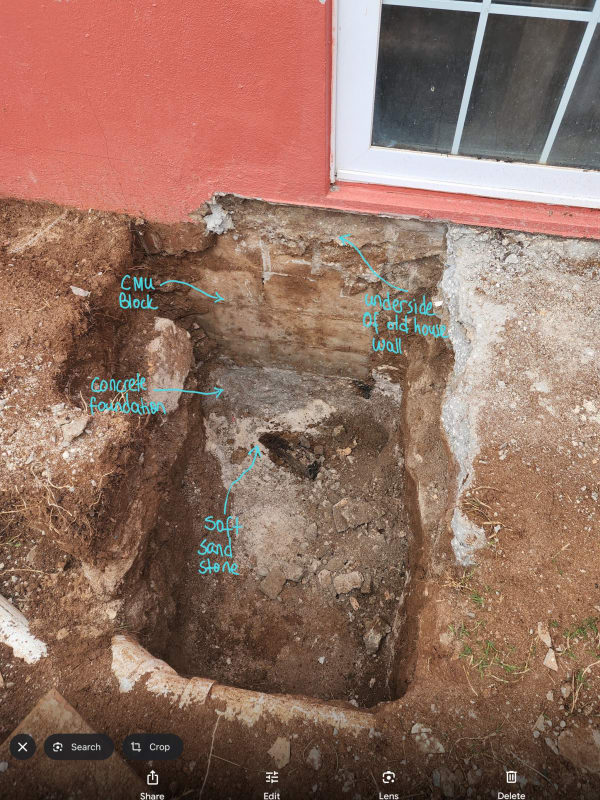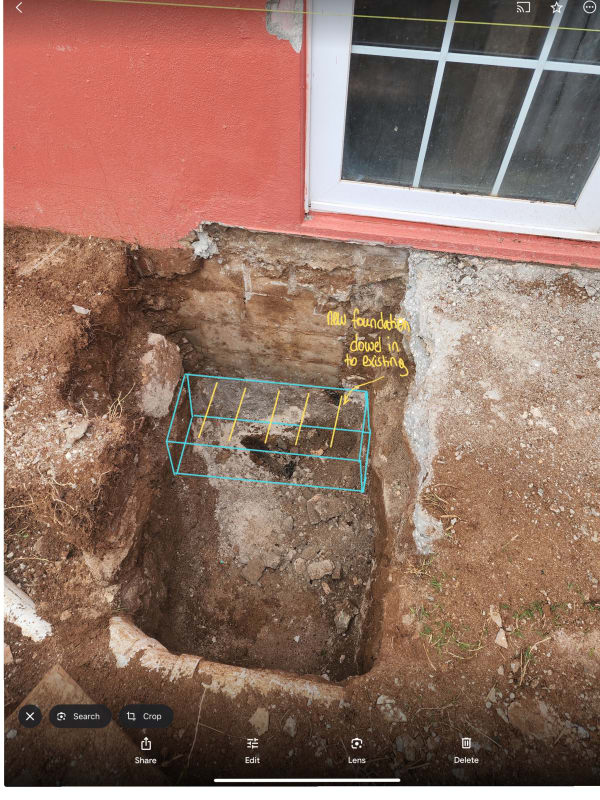psychedomination
Structural
- Jan 21, 2016
- 119
Hi there,
I'm working on a project where we will be adding a 2nd storey onto a residential house. The existing house is very old so I wasn't expecting it to have any proper foundations.
As a result, I was intending on underpinning the existing 8" hollow CMU house wall with a 2' wide x 1' deep shallow unreinforced mass concrete foundation.
The line loads were quite low at 65kN/m, so an unreinforced mass concrete foundations seemed to work fine. The 2'x1' footing size resulted in a bearing pressure of around 100kPa. Typically for soils in the area, I would assume a max of 150kPa.
The contractor started to excavate one of the underpin bays today and we found that the house was actually extended down ~3' below grade to a soft rock bearing material and it did appear to have a concrete foundation. The rock appeared to be soft sandstone or limestone. I tried to dig it up with a shovel but the shovel was unable to properly penetrate the rock. If hitting with the pointy edge of the shovel, it may go in like 1/4" The existing concrete foundation extended about 4" from the outside of the house wall but when I came back to the site later that day I noticed that the contractor removed this when he excavated deeper... which I wasn't expecting him to do. See the image below :

I would like some advice on what I should do next in this situation.
I was assuming that the soft rock would have a bearing capacity of around 400kPa, which may be conservative based on this literature : Link . There is no geotech in my area, so I need to make a reasonable and safe assumption.
With the 4" concrete nib removed and assuming there is no nib on the other side, an 8" block wall bearing directly on the soft rock would have a bearing pressure of 320kPa, which based on the above literature, the soft rock should be able to handle quite easily.
My question is :
1. Since the bearing capacity seems adequate, should I just leave this foundation as is (note, the 4" offset was only removed on this one 3' bay, the rest of the bays would likely have that 4" concrete foundation nib/extension) and just build the 2nd storey on top?
Or
2. Should I try to re extend the footing width to get the 4" back and more. Something like this?

or
3. Should I forget about the existing concrete foundation and build up the underpin with hardcore, break open a few masonry courses and pour a new foundation like what I was initially planning to do? This would require full underpinning for all the bays.

or
4. An alternative someone else can offer
Obviously underpinning is slow and expensive, so I'm more inclined to not do it if I don't need to but checking to see if there is any obvious reason that I should be doing it that I am missing. My main initial concern was settlement, but as it's on soft rock, that shouldn't be a problem.
Any guidance would be greatly appreciated.
Regardless of the option chosen, I'm still going to get the contractor to excavate another bay further from this one that was marked for underpinning to confirm that the soft rock is consistent at the same level.
I'm working on a project where we will be adding a 2nd storey onto a residential house. The existing house is very old so I wasn't expecting it to have any proper foundations.
As a result, I was intending on underpinning the existing 8" hollow CMU house wall with a 2' wide x 1' deep shallow unreinforced mass concrete foundation.
The line loads were quite low at 65kN/m, so an unreinforced mass concrete foundations seemed to work fine. The 2'x1' footing size resulted in a bearing pressure of around 100kPa. Typically for soils in the area, I would assume a max of 150kPa.
The contractor started to excavate one of the underpin bays today and we found that the house was actually extended down ~3' below grade to a soft rock bearing material and it did appear to have a concrete foundation. The rock appeared to be soft sandstone or limestone. I tried to dig it up with a shovel but the shovel was unable to properly penetrate the rock. If hitting with the pointy edge of the shovel, it may go in like 1/4" The existing concrete foundation extended about 4" from the outside of the house wall but when I came back to the site later that day I noticed that the contractor removed this when he excavated deeper... which I wasn't expecting him to do. See the image below :

I would like some advice on what I should do next in this situation.
I was assuming that the soft rock would have a bearing capacity of around 400kPa, which may be conservative based on this literature : Link . There is no geotech in my area, so I need to make a reasonable and safe assumption.
With the 4" concrete nib removed and assuming there is no nib on the other side, an 8" block wall bearing directly on the soft rock would have a bearing pressure of 320kPa, which based on the above literature, the soft rock should be able to handle quite easily.
My question is :
1. Since the bearing capacity seems adequate, should I just leave this foundation as is (note, the 4" offset was only removed on this one 3' bay, the rest of the bays would likely have that 4" concrete foundation nib/extension) and just build the 2nd storey on top?
Or
2. Should I try to re extend the footing width to get the 4" back and more. Something like this?

or
3. Should I forget about the existing concrete foundation and build up the underpin with hardcore, break open a few masonry courses and pour a new foundation like what I was initially planning to do? This would require full underpinning for all the bays.

or
4. An alternative someone else can offer
Obviously underpinning is slow and expensive, so I'm more inclined to not do it if I don't need to but checking to see if there is any obvious reason that I should be doing it that I am missing. My main initial concern was settlement, but as it's on soft rock, that shouldn't be a problem.
Any guidance would be greatly appreciated.
Regardless of the option chosen, I'm still going to get the contractor to excavate another bay further from this one that was marked for underpinning to confirm that the soft rock is consistent at the same level.
